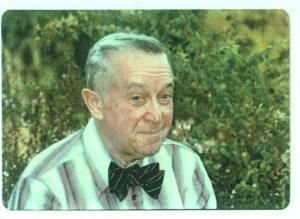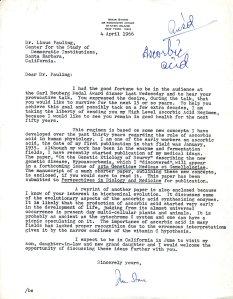
Irwin Stone. (Image by Oscar Falconi)
[Part 1 of 2]
Dr. Irwin Stone was a biochemist and chemical engineer who maintained a particular interest in and enthusiasm for vitamin C. Stone was the person who first raised Linus Pauling’s interest in vitamin C, leading to Pauling’s extensive program of research on vitamin C and its uses for the prevention and treatment of disease. Pauling’s contributions to the field are one of the big reasons why many people believe in taking vitamin C for the prevention and treatment of colds today. But for Pauling, it all started with Irwin Stone.
Stone was born in 1907 and grew up in New York City. He attended the College of the City of New York and then worked at the Pease Laboratories, a well-known biological and chemical consulting lab, from 1924 to 1934. Stone started out as a bacteriologist, but was promoted to Assistant to the Chief Chemist and then to Chief Chemist.
In 1934 the Wallerstein Company, a large manufacturer of industrial enzymes, recruited Stone to set up and direct an enzyme and fermentation research laboratory. Ascorbic acid, or vitamin C, had just been identified and synthesized by a Hungarian research team led by Albert Szent-Györgyi, who later won the 1937 Nobel Prize in Medicine for his work. Stone pioneered processes for implementing the antioxidant properties of ascorbic acid in industrial settings. One specific application that Stone developed was the use of ascorbic acid as a preservative for food – an innovation that landed him three patents.
Stone’s interest in vitamin C lasted throughout his life. He began to study scurvy intensely and by the late 1950s he had formulated a hypothesis that scurvy was not merely a dietary issue, but a flaw in human genetics. (He called it “a universal, potentially-fatal human birth defect for the liver enzyme GLO.”) Stone considered the amount of vitamin C that nutritionists recommended in a healthy diet – the Recommended Daily Allowance (RDA) - to be far from sufficient. In 1968 that recommendation was 55 mg for women and 60 mg for men. The current standard is slightly increased at 75 mg for women and 90 mg for men, with higher recommendations for pregnant and lactating women. But none of these figures are anywhere near Stone’s recommendations.
Stone believed that humans suffer from “hypoascorbemia,” a severe deficiency of vitamin C, caused by our inability to synthesize the substance the way that virtually all other mammals do. Most other mammals synthesize vitamin C in large quantities relative to body weight; proportionately, humans theoretically should be taking between 10-20 grams daily. Stone suggested that about 25 million years ago the primate ancestors of human beings lived in an environment in which they were able to consume relatively massive amounts of ascorbic acid, compared with what we get from our diets today. These material circumstances created an environment in which a genetic mutation occurred that allowed these human ancestors to stop synthesizing the substance. In present day, Stone noted, these amounts of ascorbic acid are not readily available in our diets, so humans may only be getting 1-2% of what they need.
This hypothesis initially led Stone to propose a vitamin C intake of 3 grams for optimal health, 50 times the RDA, and as he further researched ascorbic acid, he recommended increasingly higher doses. He was convinced that taking less than the amount that he recommended would cause “chronic subclinical scurvy,” a state of lowered immunity that increased susceptibility to a variety of illnesses. He felt that large doses of ascorbic acid should be used to prevent and treat infectious and cardiovascular diseases, collagen breakdown, cancer, SIDS, birth defects, AIDS, and health problems normally associated with aging.
Practicing what he preached, Stone and his wife began taking megadoses of vitamin C and they found that it greatly improved their overall health. When the couple both incurred injuries from a serious car accident, they treated themselves in part with large doses of vitamin C and reported a swift recovery. Stone attributed their rapid healing to the large doses of vitamin C.

Letter from Irwin Stone to Linus Pauling, April 4, 1966. This is the communication that spurred Pauling’s interest in vitamin C.
In March 1966, Linus Pauling gave a speech on the occasion of his receiving the Carl Neuberg Medal for his work in integrating new medical and biological knowledge. In the speech, Pauling – who was 65 years old at the time – mentioned that he hoped to live for another fifteen years so that he might see several advances of science in medicine that he anticipated to be emerging during that time period.
Irwin Stone was in the audience at this lecture and, on April 4, 1966, he wrote Pauling a fateful letter in which he noted
You expressed the desire, during the talk, that you would like to survive for the next 15 or so years….I am taking the liberty of sending you my High Level Ascorbic Acid Regimen, because I would like to see you remain in good health for the next 50 years.
Pauling was initially skeptical of Stone’s advice, but he had recently learned about other uses of megavitamin therapy and their successes, so he decided to give the regimen a try. It was at that point that Linus and Ava Helen Pauling began taking 3 grams of vitamin C a day.
In July Pauling wrote back to Stone: “I have enjoyed reading your paper and manuscript about hypoascorbemia. I have decided to try your high level ascorbic acid regimen, and to see if it helps me to keep from catching colds.”
Pauling, as it turned out, was impressed by the results. For most of his adult life, he had suffered from severe colds several times a year and had taken a daily dose of penicillin off and on from 1948 to the early 1960s. Pauling thought that the penicillin doses were his primary defense against colds but, in all likelihood, he was probably just killing off his good bacteria and making himself more susceptible to colds through his overuse of antibiotics. Once the Paulings started taking vitamin C, they reporting a noticeable uptick in their physical and emotional energy, and seemed to suffer from fewer colds.
Two years after their initial communications, Stone noticed that Pauling had cited him in a recently published journal article. Stone described his difficulties in getting his research published and the backlash that he was experiencing from physicians. He also asked about Pauling’s health.
The last time I wrote you in 1966, you mentioned that you were going to try my high level ascorbic acid regimen to see if it would help prevent your catching colds. How did it work? At the time you also had a broken leg. I know from personal experience [a reference to his car accident] that it is excellent in bone healing.
Pauling replied
I can report that both my wife and I have been less troubled by colds during the last two years, during which we have been taking 3 to 5 grams of ascorbic a day, than we had been before beginning your regimen.
He also asked about Stone’s research on ascorbic acid and leukemia.
During the late 1960s, Pauling did not make a point of promoting vitamin C megadoses, though he did support the use of megavitamin therapy for the treatment of schizophrenia. But by 1969, he was finally fully convinced of Irwin Stone’s arguments as well as his own personal successes with vitamin C, and he begin to promote vitamin C publicly.
